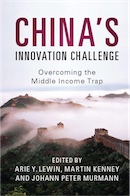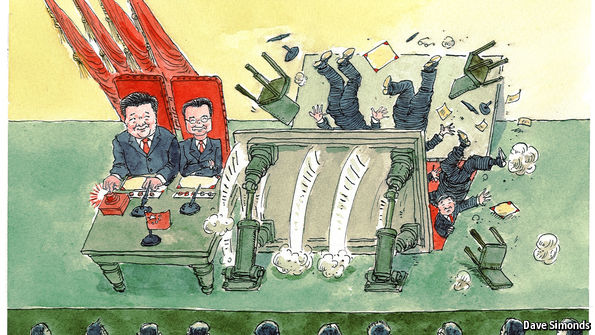
I published a new open-access research article in Strategy Science on how a Chinese company was able to create a new-to-the-world innovation. The company is Tencent and the product is Wechat, which most Chinese people use every day.
Abstract: Chinese firms have been widely seen as imitative. This historical case study explores what organizational mechanisms allowed Tencent, a Chinese firm in the fast-changing instant messaging (IM) service sector, to achieve a new-to-the-world innovation with its WeChat smartphone app. Tracing the competitive dynamics in the Chinese IM sector from its inception, we found that Tencent was able to create the innovative WeChat product through a crisis-induced intrafirm coopetition dynamic that was embedded in variation-selection-retention evolutionary processes spanning the market, the firm, and the business unit levels. Building on the intrafirm coopetition and evolutionary literatures, the paper shows that three business units simultaneously competed and cooperated in developing alternative IM products while being exposed to market selection for survival. The coopetition dynamic took place in three key areas: technology, product promotion, and complementary assets of suppliers. The relative balance between competition and cooperation changed over time, and top management guidance and firm-level routines were essential in managing the challenges of coopetition within the firm. Read full article
At the Academy of Management Meeting, held on-line because of COVID, I presented this paper in two parts.
The first video gives a theorectical background for the paper (10min).

In this 2 min video, I explain the one thing everyone should know about how China became economically so successful. Huawei is just an example of a larger story.

By Xiaobo Wu, Johann Peter Murmann, Can Huang, and Bin Guo
The book is coming out in April 2020.
Huawei has become China’s most prominent multinational company and a leader in the ICT sector. Given unprecedented access to the company, the authors of this book examine the management transformation of Huawei from its inception in 1987 until 2019, observing in detail not only the creation of its organizational routines but also the breaking of routines across most major functional areas: management, product development, HR, supply chain, finance, R&D, intellectual property, and international business. “Dynamic capabilities” are central to theories of competitive advantage and this book highlights Huawei as an ideal case study for the successful implementation of change routines and change-supporting values. The chapters cover all the major change initiatives the firm has undertaken since 1996 to import best practices from the west, with the help of consultants. The insights presented in the book will be particularly interesting for academics in the field of strategy, management, and business history.
More Info on Book.
After reading Jacobides, MacDuffie, and Tae (2016), the success of Tesla in launching a new automobile company in a crowded sector puzzled us. Jacobides, MacDuffie, and Tae (2016) had convinced us that developing the capabilities to become the manufacturer of a complete, safe automobile system would be quite difficult. Researching the development history of Tesla, we have pieced together the key features of how Tesla achieved its successful entry into the automobile sector. From this we have concluded, based on the development time and costs associated with the Tesla Model S, that a well-funded company could develop a new electric vehicle (EV) from scratch and move it into production within 3 to 5 years, by spending $1–2 billion of capital for design, development, and manufacturing. Without a doubt, increasing production to the levels of mass producers would take much longer, but the Telsa example demonstrates that new entry into the industy has become feasible. Tesla’s trajectory, from start-up on the brink of bankruptcy to a company mass producing electric vehicles within 5 years, raises important questions about the future of the global automobile sector. What would prevent Apple and Google, two companies that clearly have the resources to fund $2B in R&D, from entering the market and contesting fiercely with the dominant OEMs such as GM, Ford, VW, Mercedes, and Toyota? There are already many ventures in the Chinese electric automobile sector, such as BYD, Qiantu, NIO, and many more. Inspired by the success of Tesla, why would Chinese software and internet giants such as Tencent and Alibaba not enter this large market given that Tesla did not have prior experience and was able to get a successful car ready for sale within 5 years? In this perspective piece, we offer our reflections on the implications of the success of Tesla for the dynamics of the global automobile sector. We will appraise the chances that Chinese firms will for the first time become leading players in pushing the frontier of automotive technology, a goal that has eluded them over the past 30 years despite massive government efforts to create strong home-grown auto companies.
There are three commentaries on our articles that make for a very spirited debate.
D. Teece “Tesla and the Reshaping of the Auto Industry” Management and Organization Review, 2018.
Finally, Liisa Välikangas provides an introduction to the “Forum on Tesla and the Global Automotive Industry” Management and Organization Review, 2018.
We could have perhaps saved a lot of money in Sydney if we had deployed this new Chinese technology.
It is now being tested in Dubai.
]]>

Full story at: http://econ.st/2e4CNHP
]]>Peking University Press is publishing the Chinese Version of China's Innovation Challenge.
中国创新的挑战:跨越中等收入陷阱

The book can be ordered in China for RMB 62.
]]>
Edited by Arie Lewin (Duke University), Martin Kenney (University of California, Davis), Johann Peter Murmann (UNSW Australia) - April 2016 - Cambridge University Press
The miracle growth of the Chinese economy has decreased from a compound annual growth rate of 10% to less than 7% in 2015, raising questions about China?s prospects of avoiding the ?middle income trap?.The two engines of growth -- exporting on a scale never before witnessed and massive infrastructure investments -- are approaching the limits of diminishing returns. Assuming that current political arrangements prevail and that western socio-political economic models are not adopted, can China develop a new growth model with innovation at its center? This volume brings together leading Chinese and international scholars who examine the role of culture, institutions, national policy, firm and individual dimensions in shaping the operation of firms, industries and technologies. Their analyses of the daunting challenges of building an innovation-driven growth model for China range from quite optimistic to deeply pessimistic. The book will appeal to scholars, policy-makers and business persons.


To date there are few research monographs that go beyond picking out striking cases of innovative companies. We clearly also need systematic analyses of China’s growing innovative capacity. For this reason, Xiaolan Fu’s book China's Path to Innovation (Cambridge University Press, 2015) is a welcome addition to the literature. Fu is Professor of Technology and International Development at Oxford and has written about innovation in China for more than ten years. China's Path to Innovation has 16 chapters (Table of Contents). The book provides an excellent overview of scholarly literature on the development of Chinese innovative capacities. It deserves to be in the library of anyone working on China’s innovative capacity. Read my full review on economic-evolution.net.
]]>The New York Times filed a report about a plan to create new mega cities surrounding Beijing. One of the big obstacles is the inability of local governments to raise their own taxes to pay for services.


But I am getting more nervous about the future of China after reading this series of articles.
]]>




